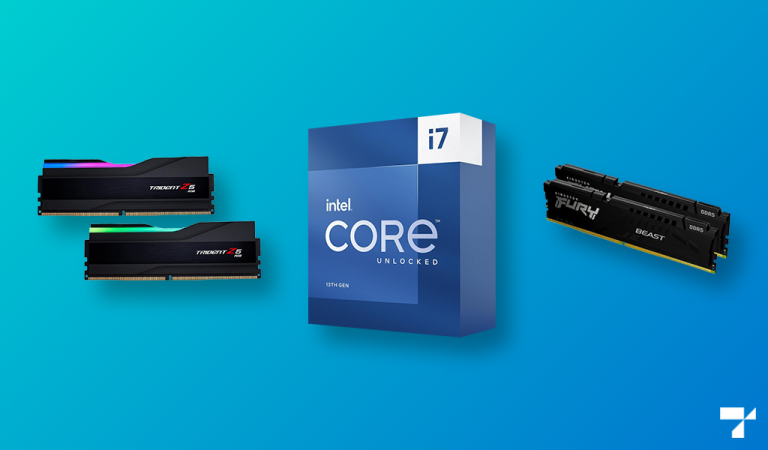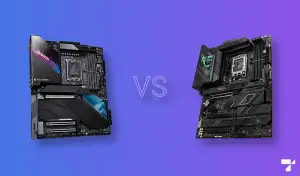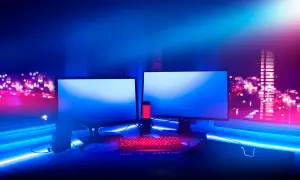DDR5 memory takes center stage with the release of Intel’s 13th Gen processors. And if you are building a PC specifically with the Core i7-13700K, it is important that you choose the right memory configuration not just based on the computationally demanding tasks you wish to perform but also taking into consideration your budget. Therefore, in this article, we will discuss what the best RAM kits for the i7-13700K are as well as how to choose the optimal one for your specific use case.
Also keep in mind that officially, the i7-13700K supports both DDR5 5600 and DDR4 3200 MHz memory with a maximum memory capacity of 128GB. However, with Intel’s XMP 3.0 memory overclocking profiles you should see higher frequencies and improved performance if your chosen RAM kit allows it.
Best RAM for Intel Core i7-13700K
1. G.Skill Trident Z5
Verdict
G.Skill Trident Z5 is a fine set of memory modules for enthusiasts that need simple but elegant aesthetics without needing to both with reliable overclocking profiles.
Specifications
Memory Type: DDR5 | Capacity: 32GB (2x16GB) | Speed: 6,000MHz | CAS Latency: 36 | Timings: 36-36-36-96 | Voltage: 1.35V | Height: 45mm/1.77″ | Warranty: LifetimeBenefits
- Great memory-application optimization
- Out-of-the-box usability
- Ambient LED lighting
Drawbacks
- Not recommended for non-productive builds
- Tall heat spreader height
Buying Options
G.Skill Trident Z5 is hands-down, the best DDR5 memory kit whenever a balanced combination of style and performance is required. Its 6,000Mhz and CL36 timings mesh well with any productivity workload that you might throw on a Core i7-13700K system, finally making DDR4 much less of an attractive option.
That being said, we do not recommend this memory kit if you are planning for a more casual build. Tiny tuning improvements might show up as FPS improvements in games, but certainly not worth the price compared to other DDR5 options.
In the aesthetics category, the G.Skill Trident Z5 earns its usual high score for its perfect balance of simple contours with stylistic edges and color combinations. It even serves a more functional purpose, as it helps better dissipate heat from DDR5’s internal power delivery systems.
The RGB lighting is also a feast for the eyes, having a soft ambient glow that touches on its straight profile without messing up the color profile of the entire PC. When paired with certain lighting strips, it gives this futuristic machine-like vibe that you would usually only appreciate with gaudier kits, like XPG’s Lancer series, for example.
2. Corsair Vengeance
Verdict
Corsair Vengeance delivers reliability and stability in a form factor and price package that proves its investment efficiency, even if it might look a bit too minimalistic for a Core i7 system.
Specifications
Memory Type: DDR5 | Capacity: 32GB (2x16GB) | Speed: 5,600MHz | CAS Latency: 36 | Timings: 36-36-36-76 | Voltage: 1.25V | Height: 35mm/1.38″ | Warranty: LifetimeBenefits
- Low-profile heat spreader
- Stable for all software use cases
- Considerable OC headroom outside its profile
Drawbacks
- Thin heat spreader
Buying Options
The 5600Mhz and CL36 of this corsair Vengeance memory may feel a bit of a step-down compared to the Trident Z5. But in terms of actual real-world performance, it doesn’t really provide that much of a negative difference. In fact, when equated against their respective prices, the Corsair Vengeance clearly wins out in this category when it comes to value you don’t mind its more minimalistic design.
This memory kit performs well in computationally demanding productivity tasks. It also performs great when it comes to gaming while being relatively cheaper when compared to other DDR5 memory. This makes the Corsair Vengeance a very attractive memory option for any Core i7-13700KPC build.
In addition, overclocking enthusiasts are also greeted with a nice headroom value. Not exactly to produce significant gains, but mostly for optimization purposes, bumping your CPU’s multitasking potential, even if just for a tiny bit.
Heat spreader design is mostly basic and linear, a no-muss and no-fuss design that reflects its product value. It mostly just serves its purpose of thermal stabilization, if you don’t count alternative users who prefer this kind of minimalistic design. It does kind of look very thin compared to other low-profile modules. But maybe that’s because the edges don’t curve inwards.
3. Kingston Technology Fury Beast (Black)
Verdict
Kingston Technology’s Fury Beast memory kit is the best bread and butter option for users who prioritize cost-to-performance, even if the numbers seem quite lower.
Specifications
Memory Type: DDR5 | Capacity: 32GB (2x16GB) | Speed: 5,200MHz | CAS Latency: 40 | Timings: 40-40-40-80 | Voltage: 1.25V | Height: 35mm/1.37″ | Warranty: LifetimeBenefits
- Straightforward OC profiles
- Low-profile heat spreader
- Best cost-to-performance option
Drawbacks
- Very barebones design
Buying Options
Stepping a bit down further the memory frequency stack, these 5,200Mhz CL40 Kingston Fury Beast modules don’t seem to impress that much, especially for a Core i7-13700K system. But underneath, you are not really losing that much either. There is a couple of percentages lost, but that is in exchange for its incredibly good cost-to-performance ratio.
The situation becomes even more positive for these RAM sticks if you are savvy enough or have enough time to test stable tuning settings. Take advantage of its baseline OC profile, and tune a good personal tweak that matches close enough to any of our previous entries. CL timings may not be as lenient, but you can still shave a few more percentages off the difference without adding cost.
As for its looks, they’re very minimalistic. You can either dismiss it as very barebones and boring or as a low-profile set of memory that blends in perfectly as part of the motherboard. No extra design flairs, and not a single hint of RGB.
For those building smaller PCs, or SFF systems, the Kingston Fury Beast adds further value by being completely unobtrusive to any additional hardware installed on the case or motherboard. You don’t have to worry about clearances, allowances, or even measurement margins.
4. Crucial Desktop Memory
Verdict
Crucial’s basic, zero-heat-spreader DDR5 modules might not look like much visually, but they are very good modules for stretching out OC performance for the Core i7-13700K on a tight budget.
Specifications
Memory Type: DDR5 | Capacity: 16GB (2x8GB) | Speed: 4,800MHz | CAS Latency: 40 | Timings: 40-39-39-77 | Voltage: 1.1V | Height: 31mm/1.23″ | Warranty: LifetimeBenefits
- Pure black PCB (as opposed to green)
- Free overclocking headroom
- Cheapest DDR5 memory
Drawbacks
- No heat spreader
Buying Options
Finally, for those that diverted all their funds on the i7-13700K, GPU, and power supply, and still want to go for DDR5, Crucial’s super basic modules can still offer almost all of what other entries could provide here. It doesn’t have any heat-spreader aesthetics, but it makes up for it by beating out every single entry here in the overall value department.
The caveat, of course, is that users of this memory kit would manually tune its frequency and timings to the best of what its silicon lottery can offer. It doesn’t have any default OC profiles. This can be quite a headache for plug-and-play users. But for overclocking enthusiasts, this will definitely satisfy their advanced hobby needs.
So far, most Crucial DDR5 4,800Mhz modules are able to OC as high as bout 5,400Mhz, which puts us into the competitive category of the previous Kingston Fury Beast entry. Take note that every stick might be different. Some could be lower, while some have the potential to jump even higher. The point is that these additions in performance come at zero cost to the user, provided that they know how to maximize the memory kit’s potential.
Thankfully, Crucial finally decided to join the rest of the black barebones memory PCB gang. So even if it doesn’t have any heat spreaders, it won’t negatively affect the overall aesthetic of your 13700k system. You can even clearly see the power delivery and memory controller at the top center portion.
How to choose the best RAM for Intel Core i7-13700K
Memory Generation Support
The Core i7-13700K still supports both DDR4 and DDR5 memory. On Alder Lake, DDR4 was still usually recommended since it provides a good chunk of savings without affecting performance. But since we are on a Core i7 Raptor Lake platform anyway, we have to go full DDR5.
Capacity
Like always, 16GB (x2 8GB) provides the best balance of price and workable capacity. But we are starting to recommend 32GB and more since it provides a nice multitasking headroom, and can sync well to productivity software that can max out a Core i7-13700K. If the investment is efficient enough, you can even go higher and buy a 64GB kit.
Frequency
The officially supported memory frequency of Intel 13th Gen is rated at 3,200Mhz for DDR4, and then 5,600Mhz for DDR5. You can go higher if your funds and system allow for it, of course. We are on a Core i7 system anyway. But take note that the gains might not really reflect well in benchmarks, or for real-world use scenarios.
Latency
Because we chose to go all out on DDR5 for the Core i7-13700K, you should not worry about any latency issues. Go as low as still can, but take note that you will be more than compensated for DDR5’s raw speeds and Raptor Lake’s general upgraded specs (especially its cache).
Dual-Rank Memory is Faster Than Single-Rank Memory
Dual-rank RAM is typically better out of the box compared to single-rank. However, single-rank are more stable to OC and can sit at slightly higher frequencies compared to their counterpart dual-rank modules when using four RAM sticks.
Dual-Channel is Better than Single-Channel
Just by installing two or four RAM sticks (instead of one or three), you essentially double the memory bandwidth available for your system’s processor.
Final Thoughts
Raptor Lake may have continued its legacy of supporting DDR4. But as the second top-of-the-line CPU of its architecture, the Core i7-13700K should now benefit greatly when DDR5 is used for its platform. And while price-to-performance is still a notable consideration, users are encouraged to spend however they could spend to get the best performance without any hassles.



